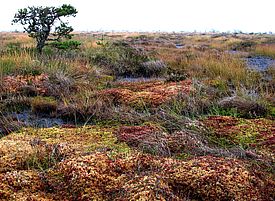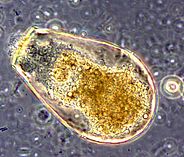For the first time, researchers at EPFL and the WSL have shown for the first time how the fate of tiny algae-harboring amoebas that live in peatlands could reinforce global warming.
The world’s peatlands store tremendous amounts of carbon – up to 20 years’ worth of human and natural emissions. While today they sequester more carbon than they release, research suggests that in a warmer world, they could decompose more quickly, reinforcing the vicious cycle of global warming by releasing additional CO2 into the atmosphere. In a recent study, scientists have investigated one of the most predominant types of peatland microorganisms and how their response to higher temperatures could impact the uptake or release of carbon by peatlands. Their findings, published in the journal Scientific Reports (Nature Publishing Group), suggest how increasing temperatures could decrease levels of carbon fixation in peatlands.
Peatlands are teeming with microorganisms – algae, bacteria, and others – with a wide range of feeding strategies. Because of their sheer abundance, these microorganisms may push their habitat towards increased sequestration of atmospheric CO2 in peatlands, or towards an increased release of the gas back into the atmosphere. But according to Vincent Jassey, the lead author of the study, "until now, nobody has ever looked into the role of the most prevalent microorganisms that are called mixotrophic testate amoebas in the peatland carbon cycle."
Much like corals, these amoebas live in symbiosis – in a mutually beneficial relationship – with tiny photosynthetic algae. While on their own the amoebas are able to feed on bacteria, they can also delegate the job to the algae they harbor, which, using photosynthesis, can transform atmospheric carbon into sugar.
The question the researchers set out to address was: would higher temperatures cause the amoebas to eat more bacteria, "breathing out" CO2 into the atmosphere as they digest their food? Or would they instead rely more heavily on their resident algae, "breathing in" the gas, transforming it, and storing the carbon in their own biomass, like plants?
To find out, they artificially warmed patches of a peatland in the French Jura Mountains for five years, studying the evolution and the behavior of the amoeba population. While they found that the amoebas continued to gain their energy thanks to the photosynthesis of their algae, the researchers were surprised by the drastic drop in their number.
"After observing the decline in the amoeba population, we had to find a way to determine how this would affect the overall carbon cycle of the peatland," explains Jassey. For this, he and his colleagues took samples of plants that form peatlands – Sphagnum mosses, densely inhabited by amoebas – into the laboratory, where, after artificially reducing the amoeba population, they could accurately measure the amount of carbon taken up and released.
These results suggest that increasing temperatures would lead to an overall decrease in the photosynthetic capacity of the mixotrophic testate amoebas. If the rising temperatures cause these specific amoeba populations to shrink, as this study suggests, peatlands could wind up fix less carbon than they usually do each year, further reinforcing global warming.
This project was led by the Environmental Systems Laboratory, a joint laboratory between the Ecole Polytechnique Fédérale de Lausanne (EPFL) and the Swiss Federal Institute for Forest, Snow and Landscape Research WSL.
Original article
Jassey, V. E. J. et al. An unexpected role for mixotrophs in the response of peatland carbon cycling to climate warming. Sci. Rep. 5, 16931; doi: 10.1038/srep16931 (2015).
Links
- EPFL press release, November 26, 2015

